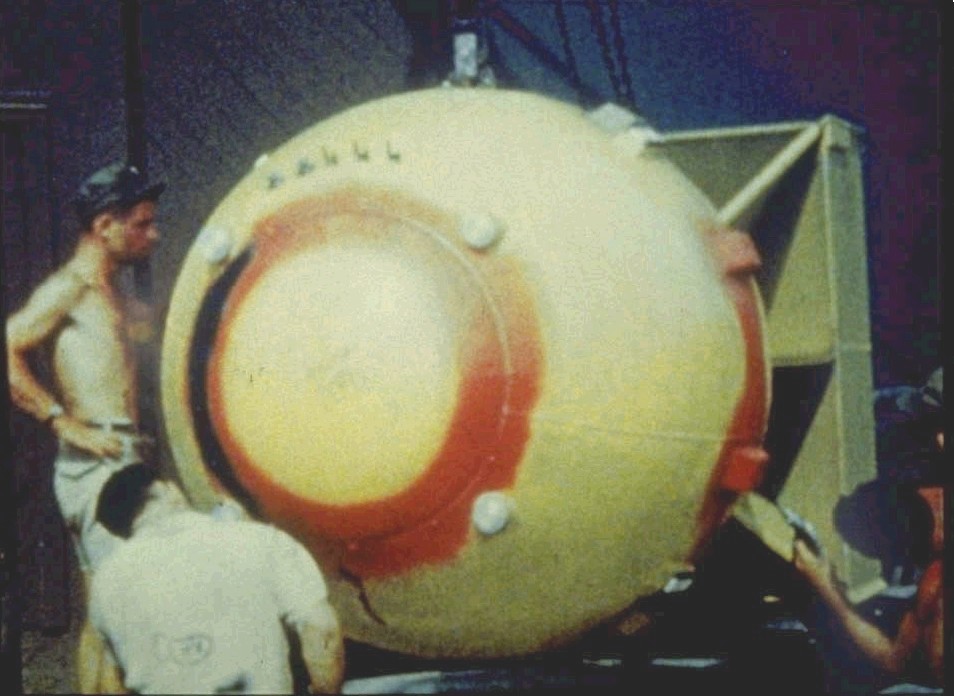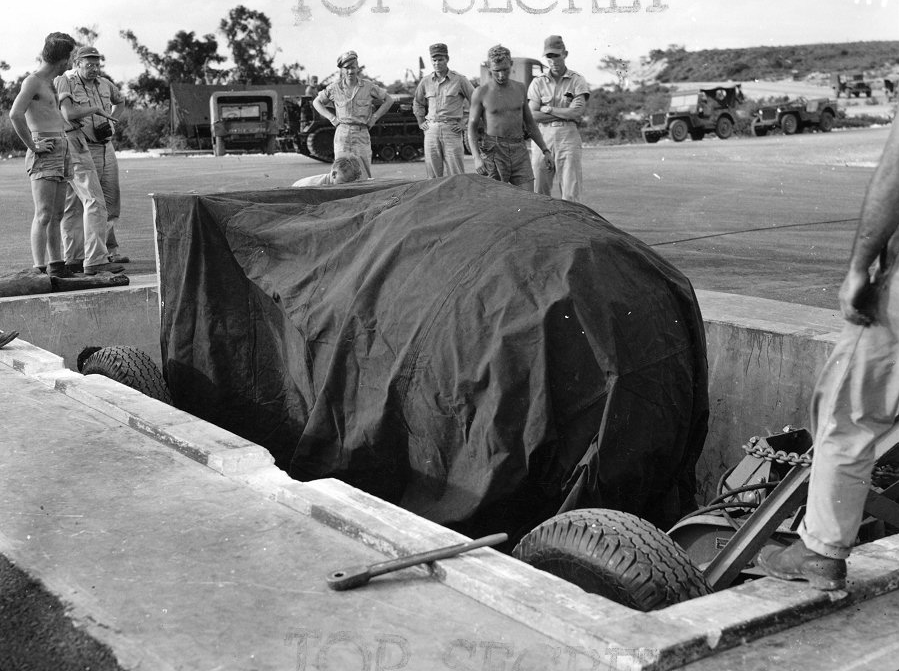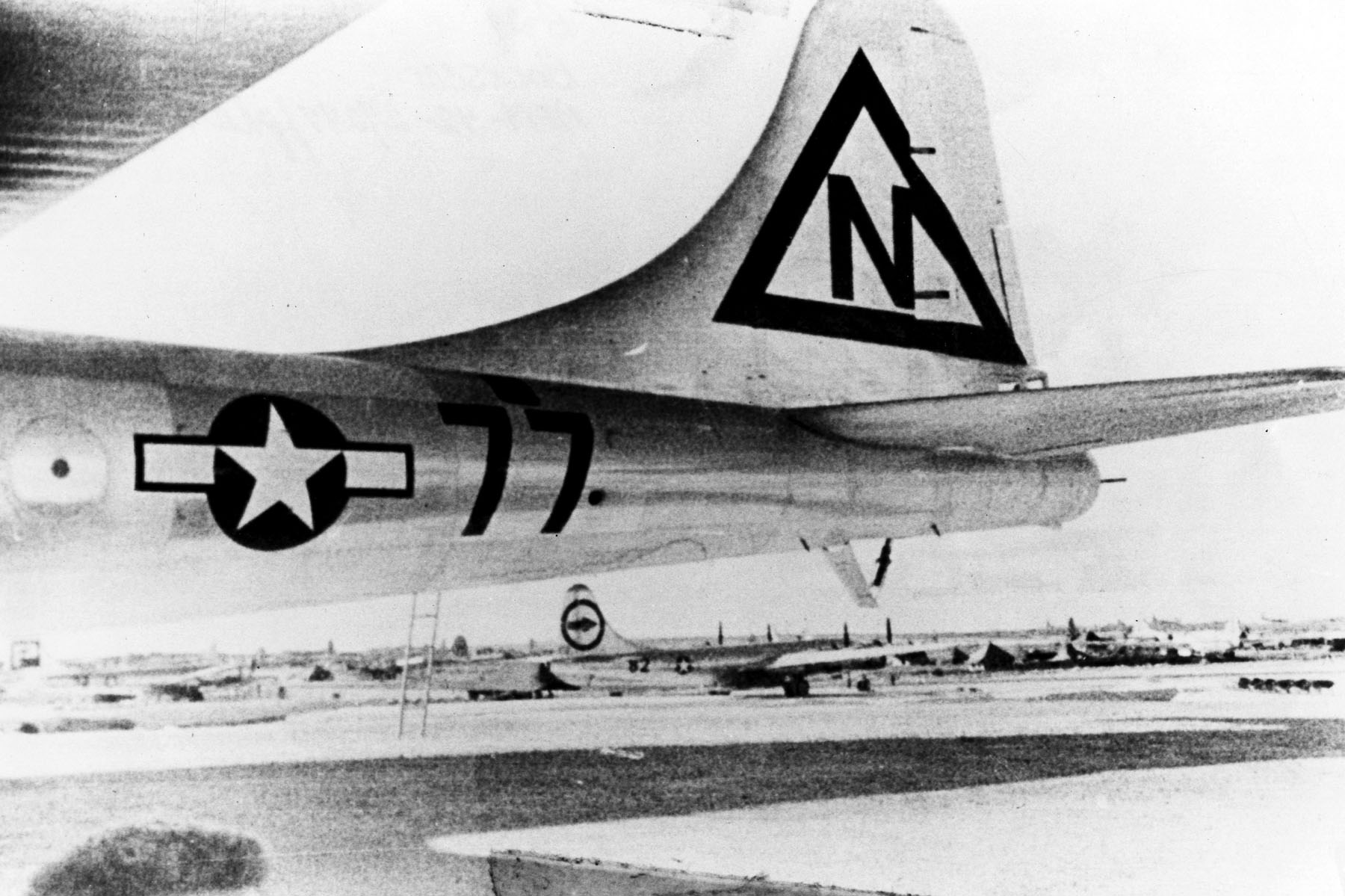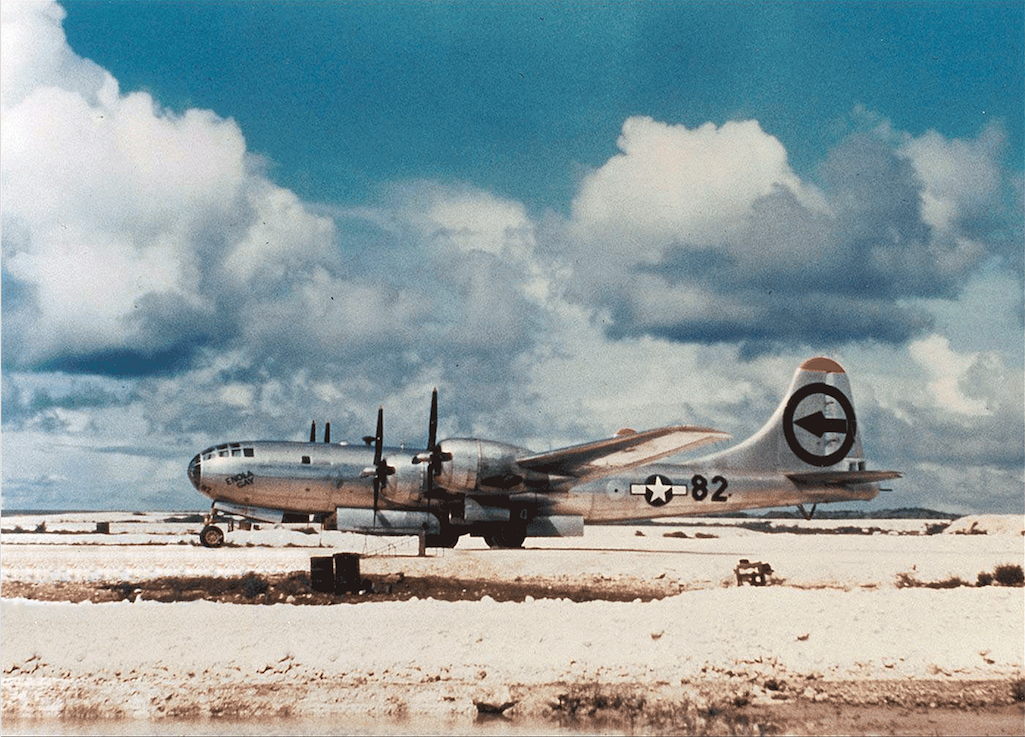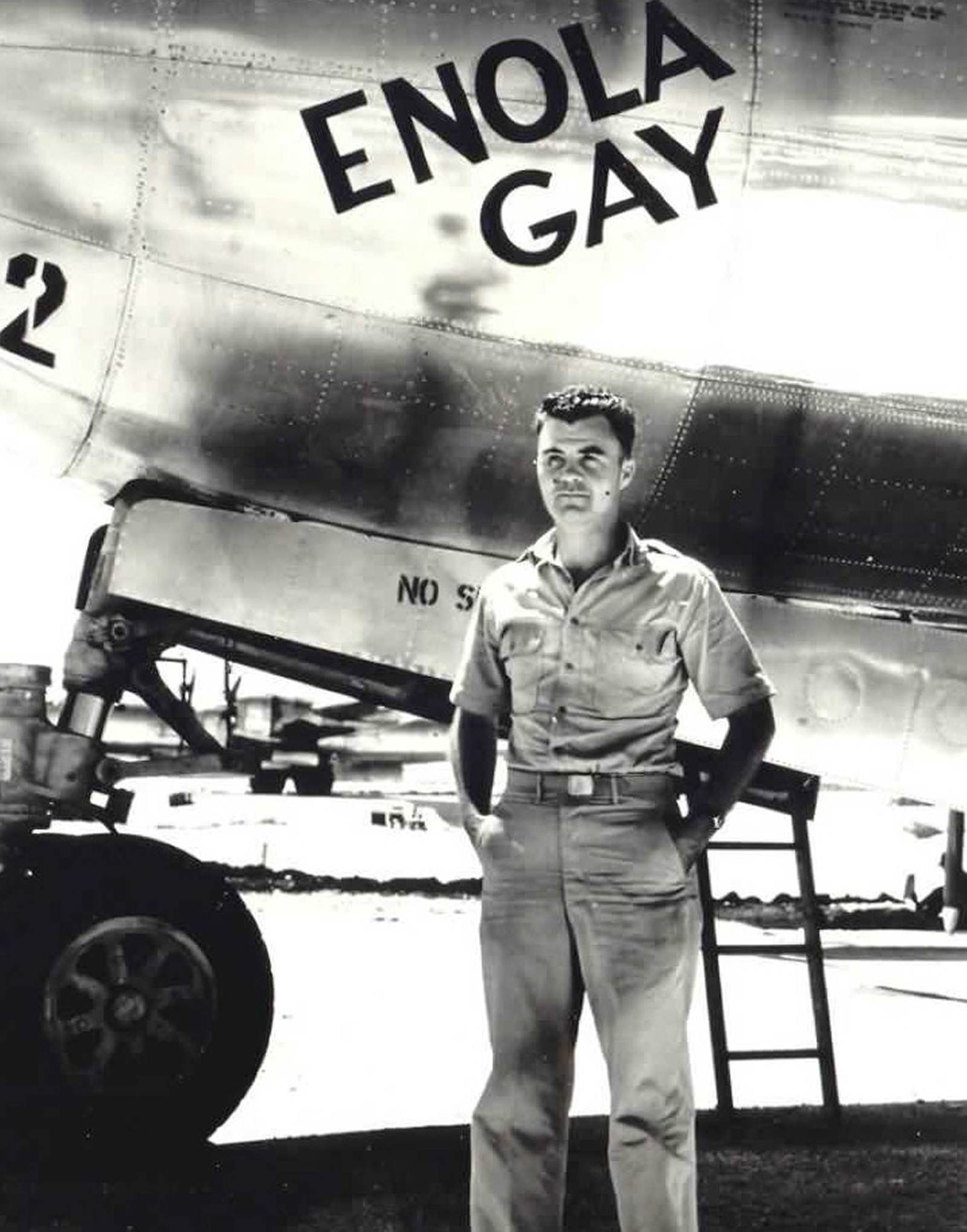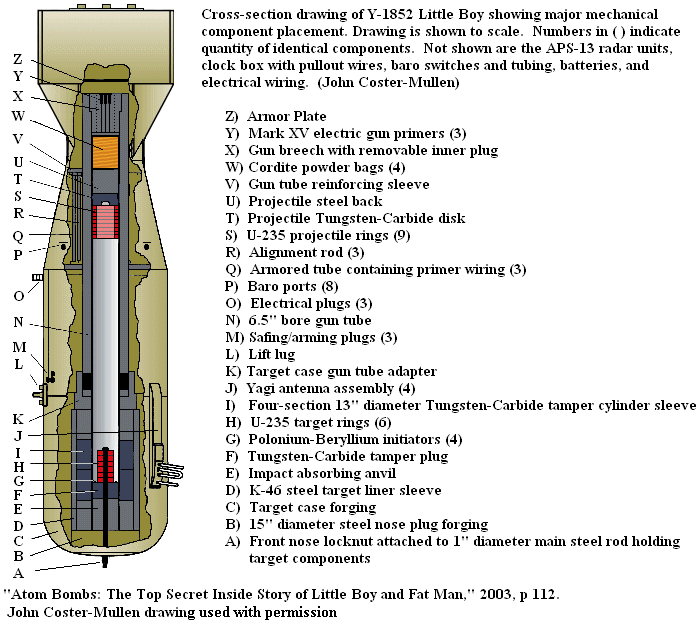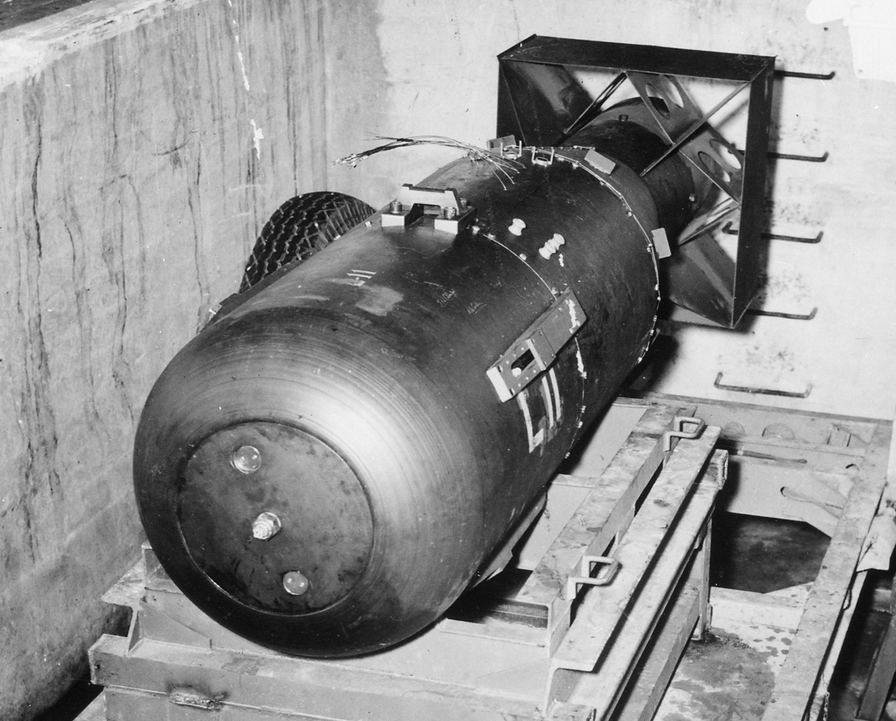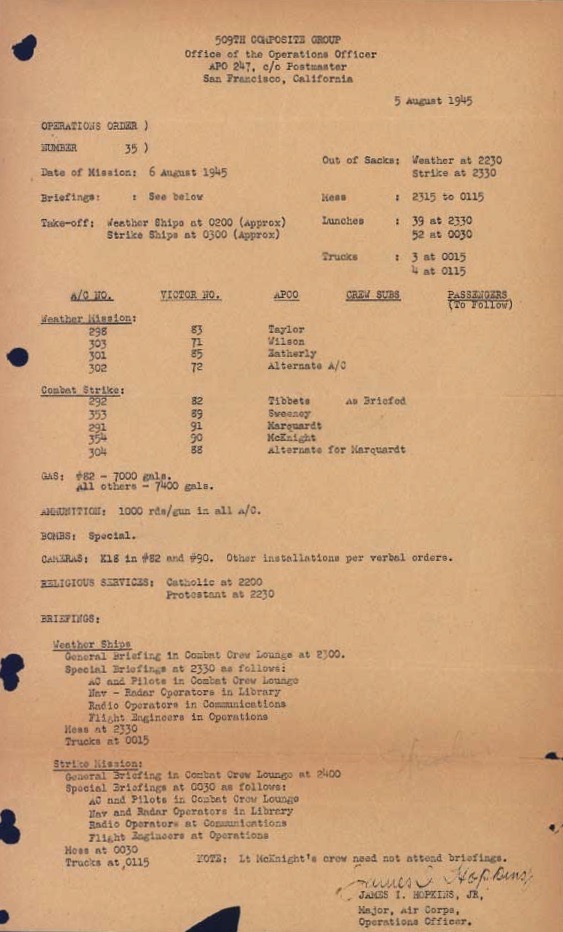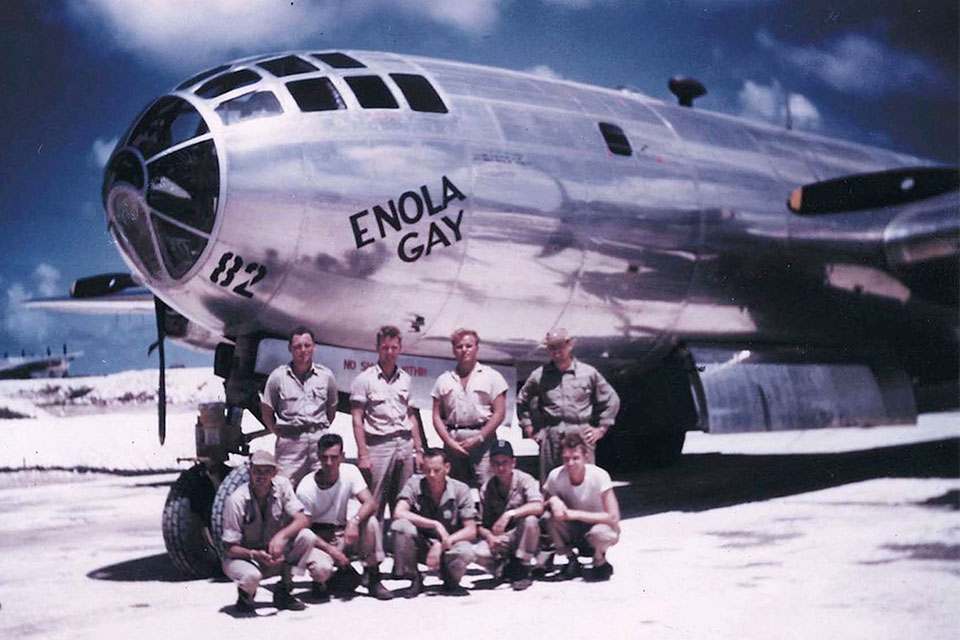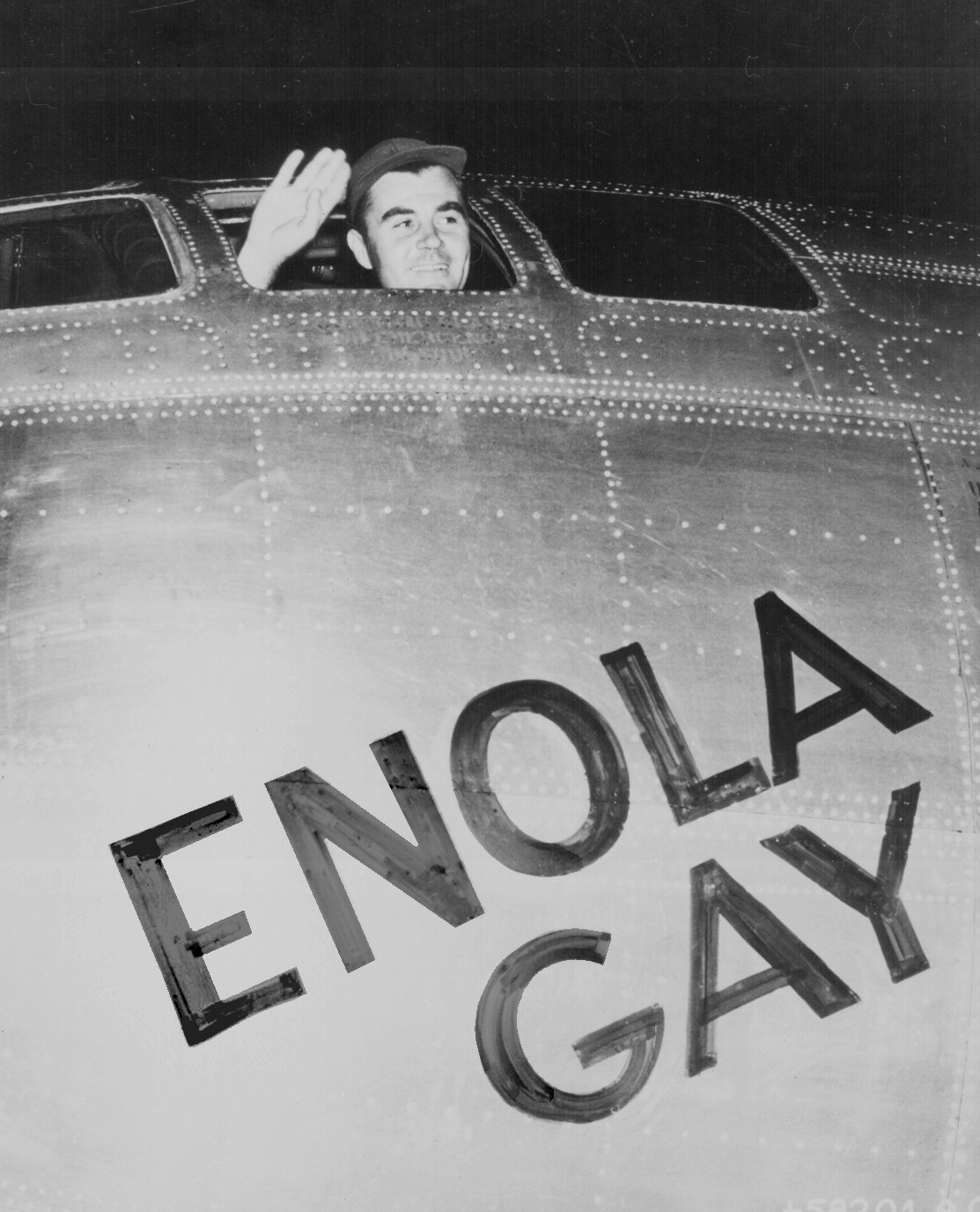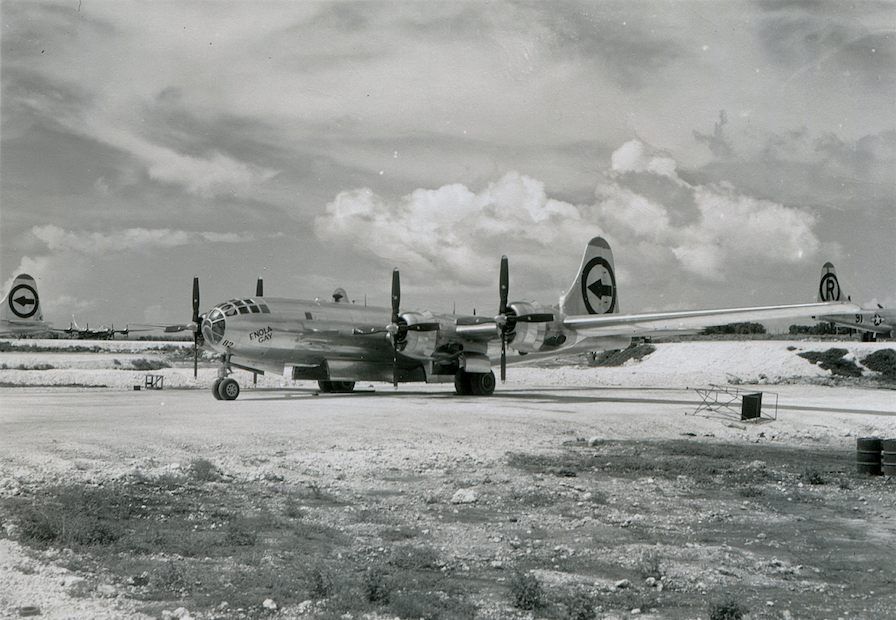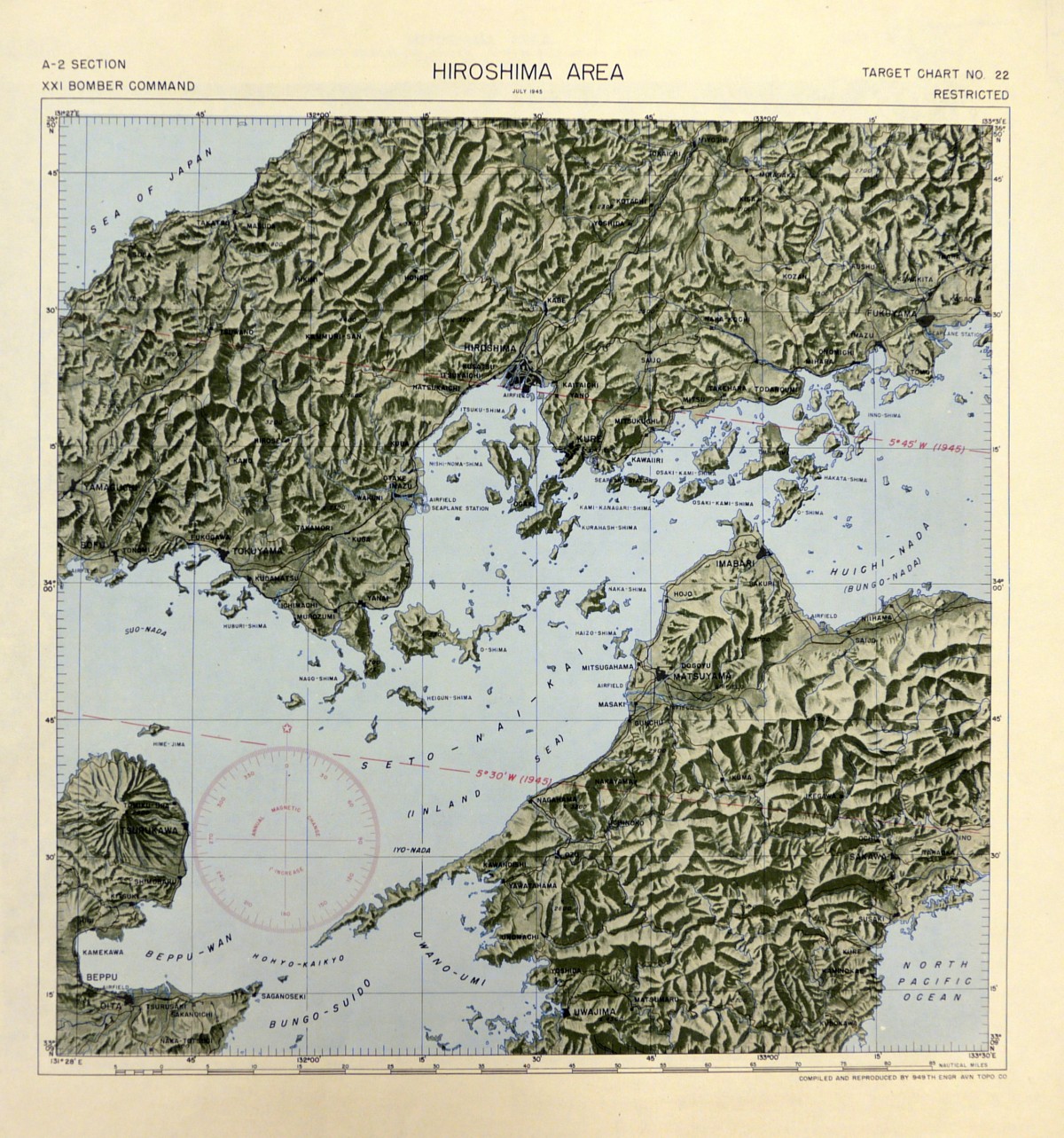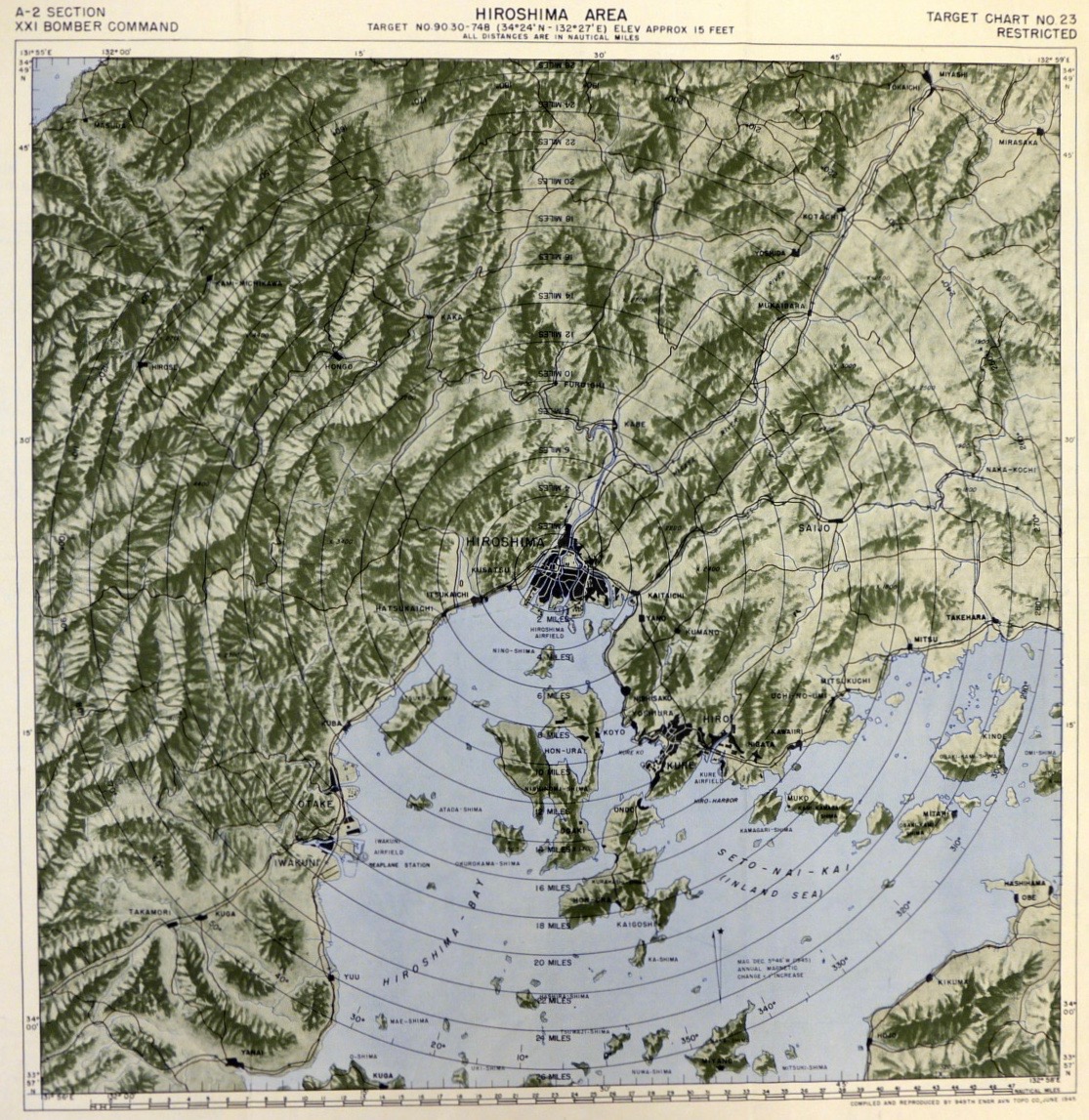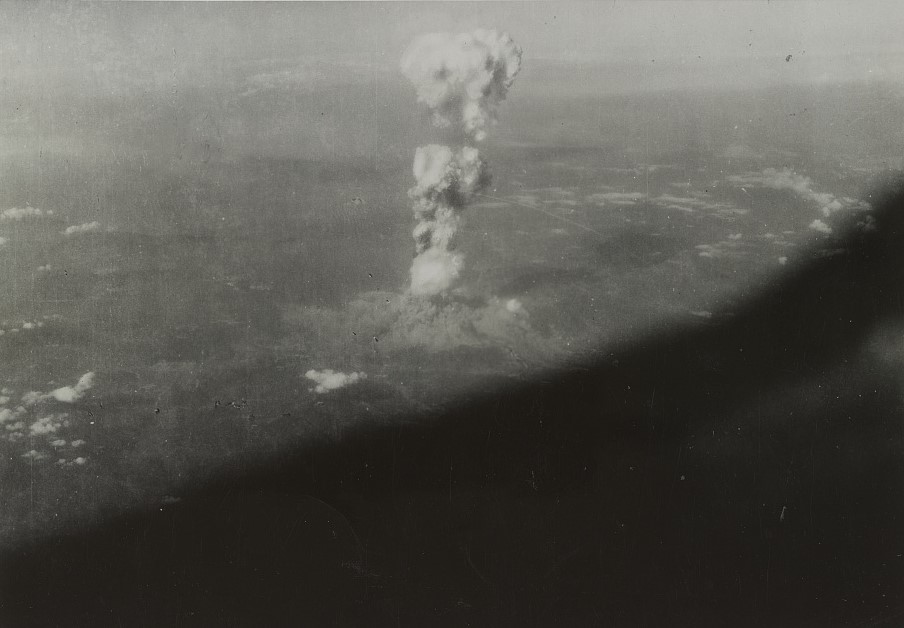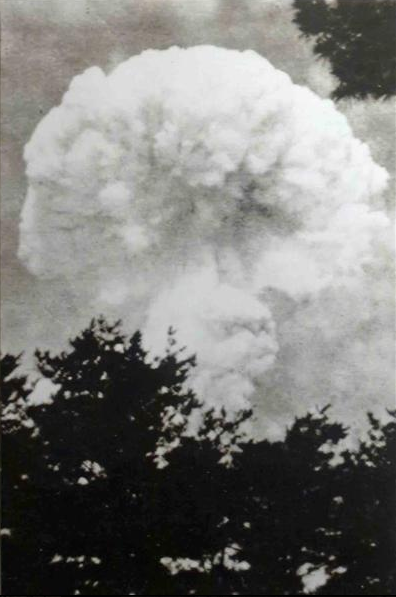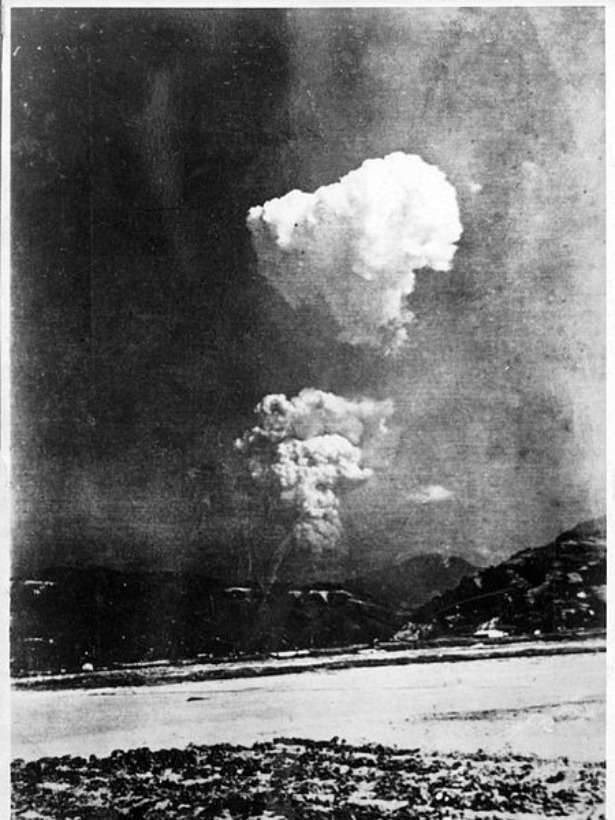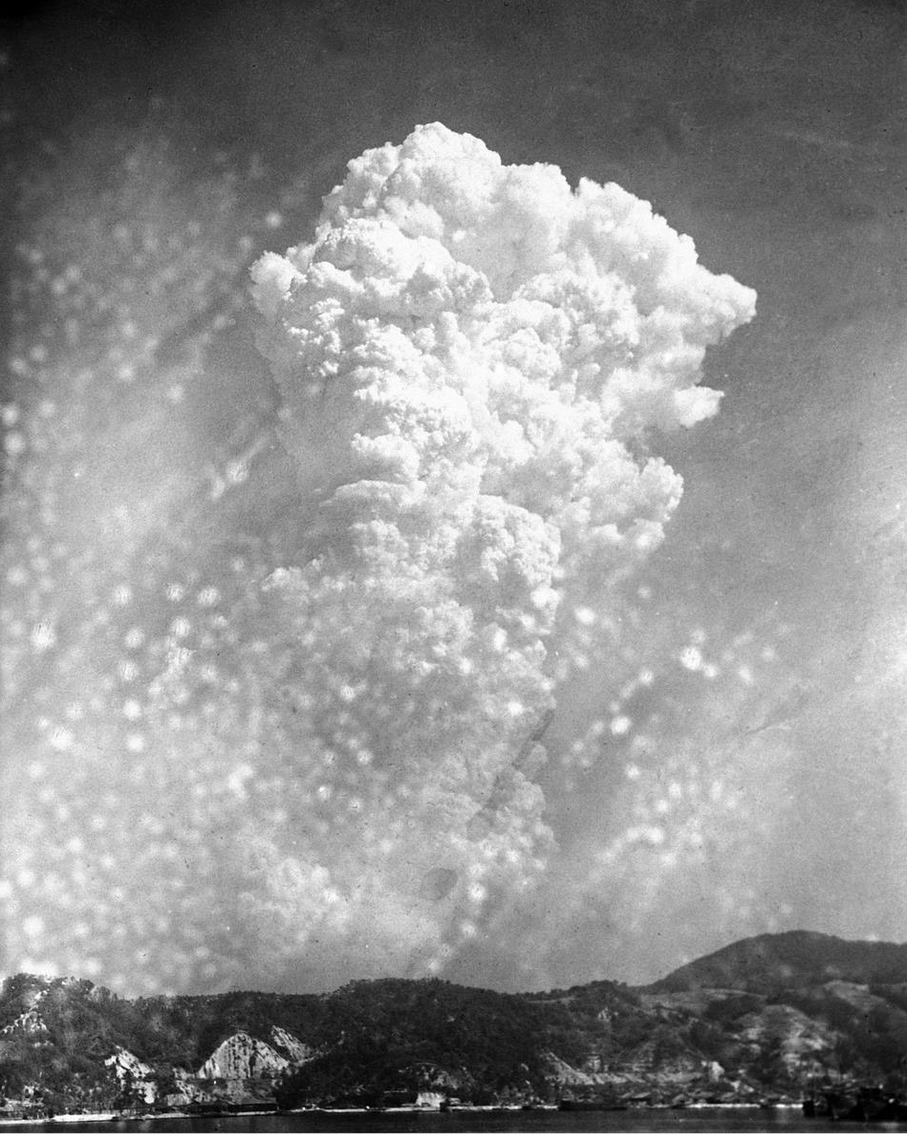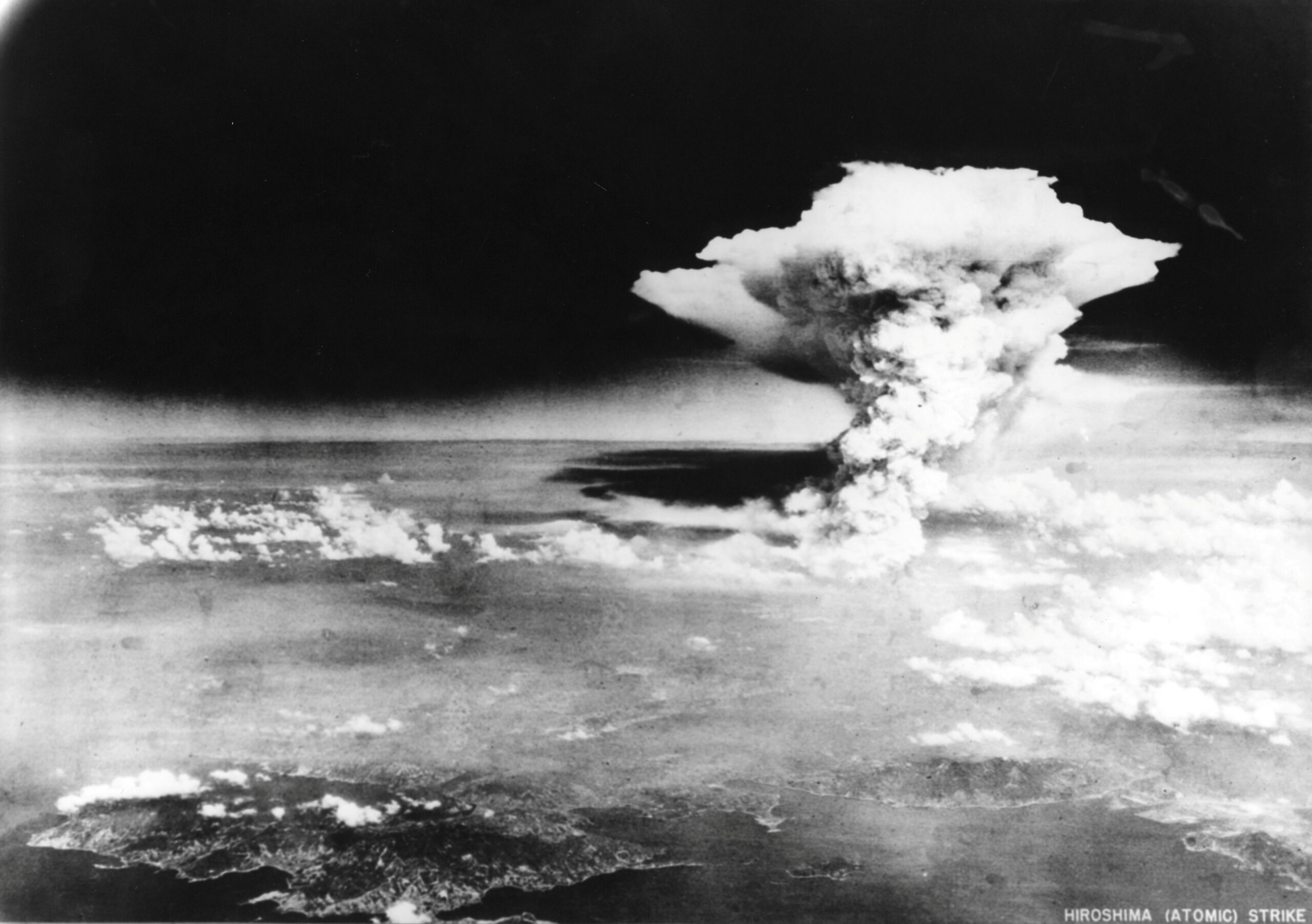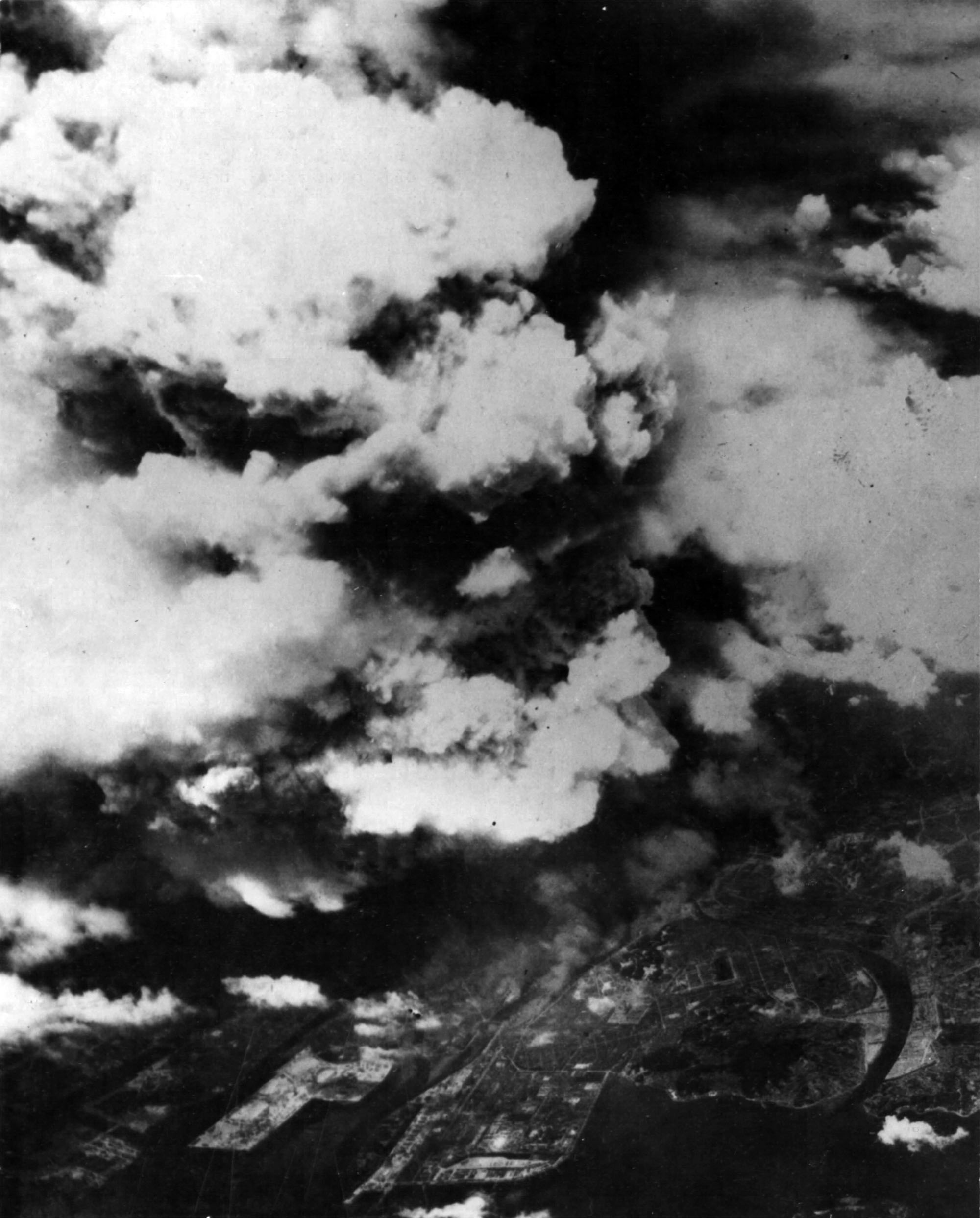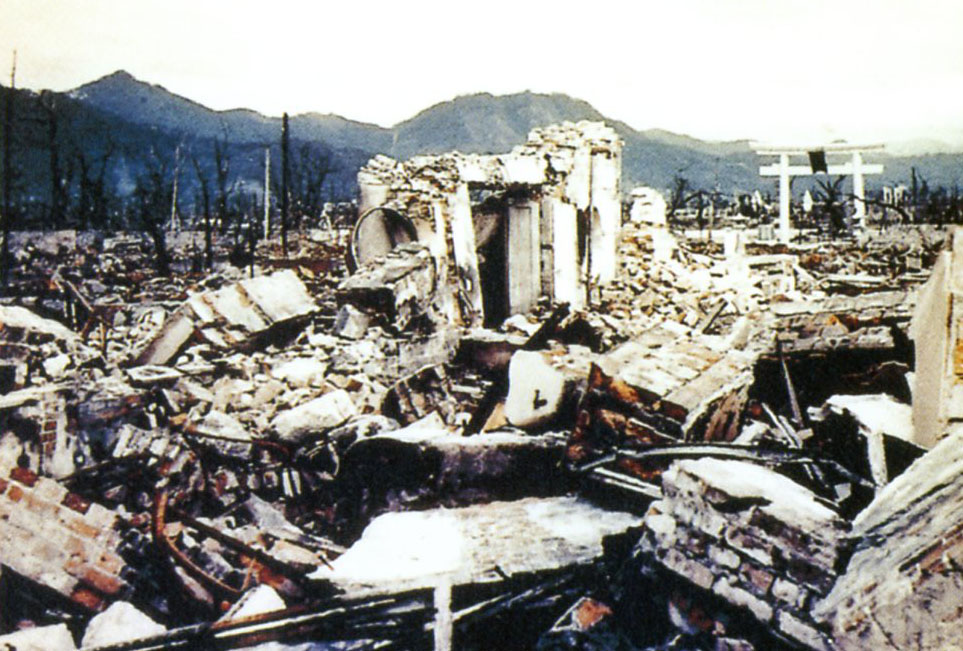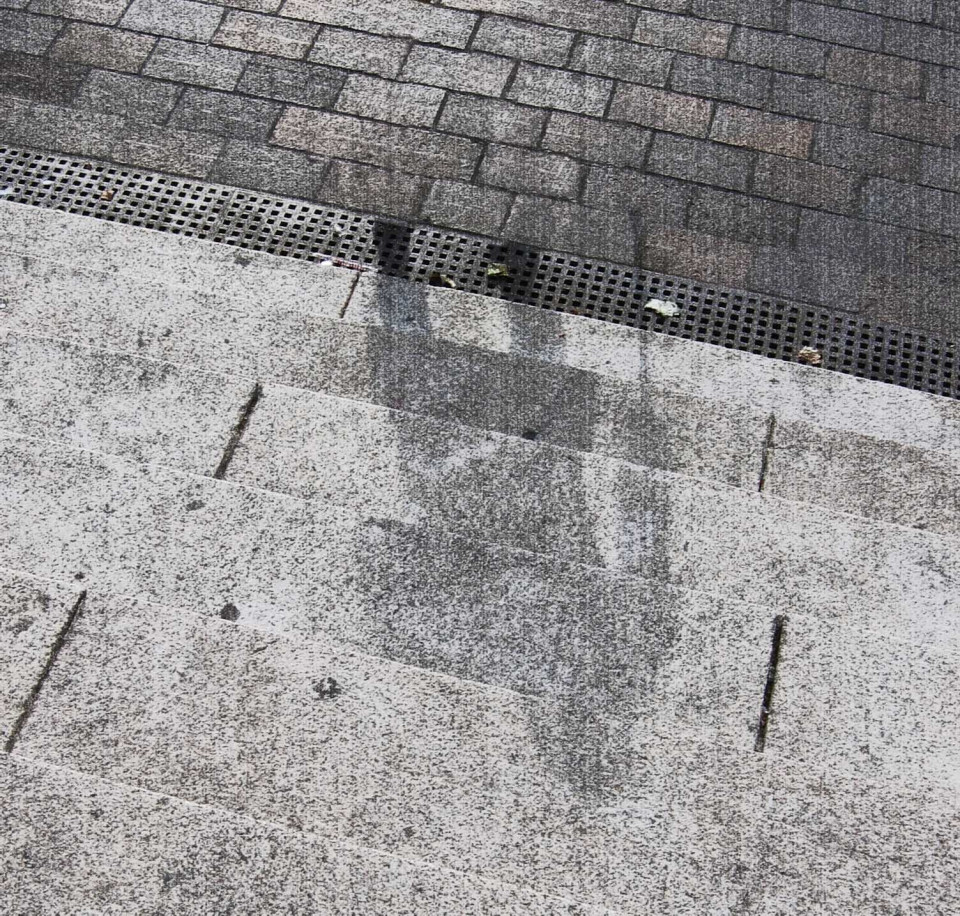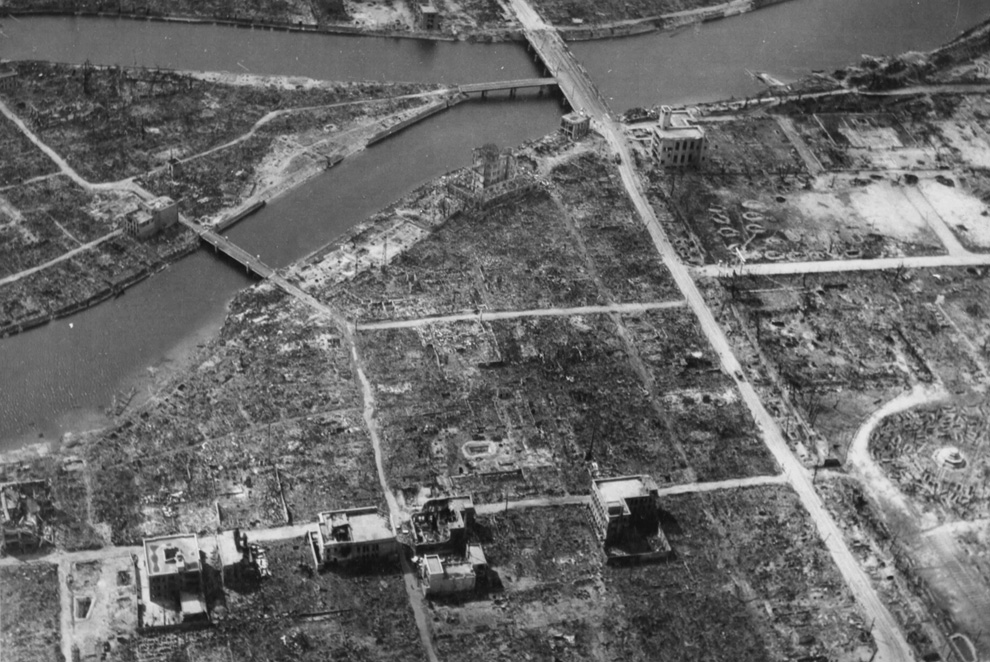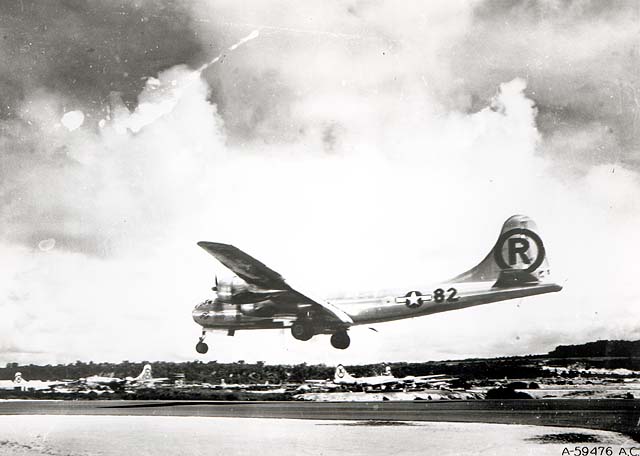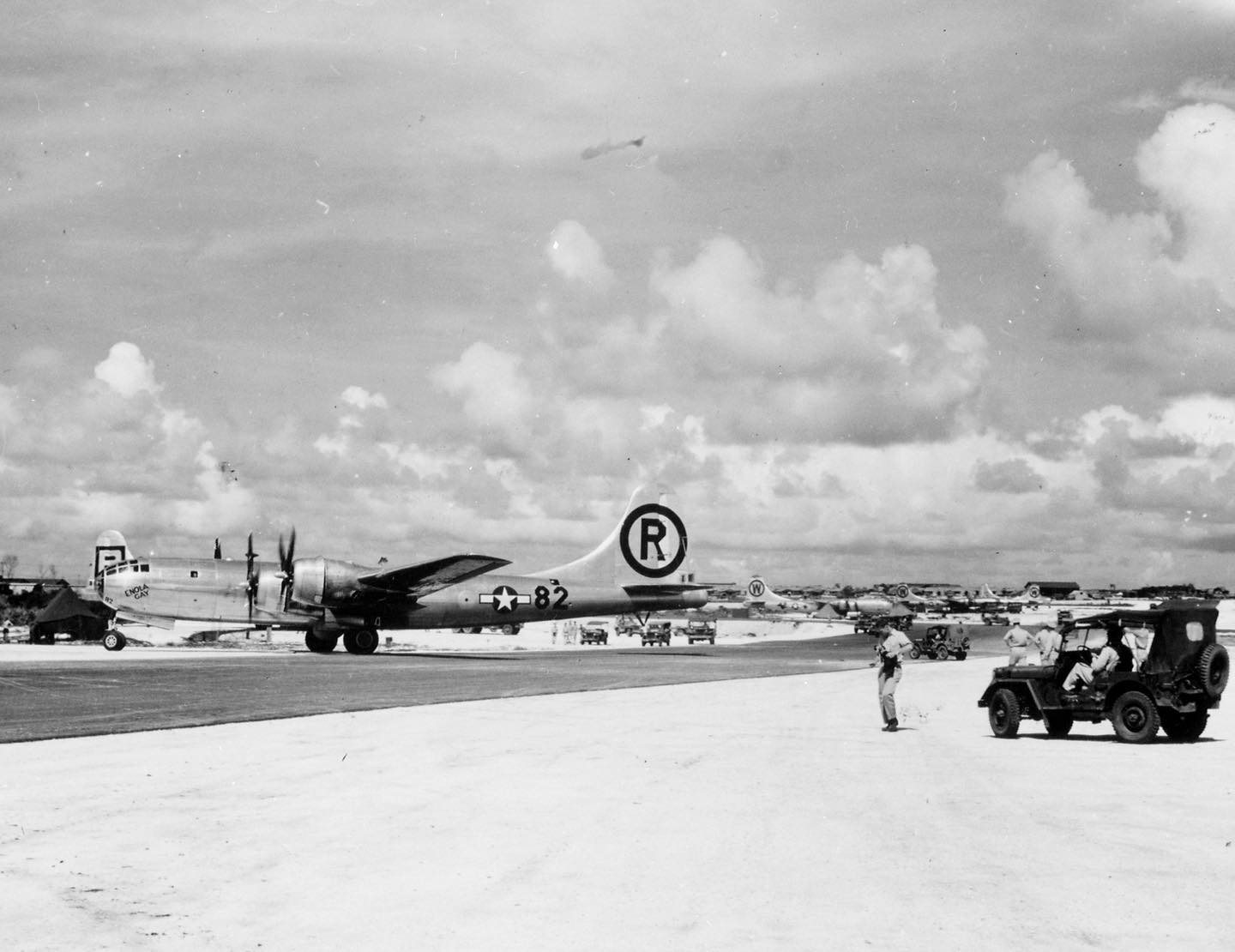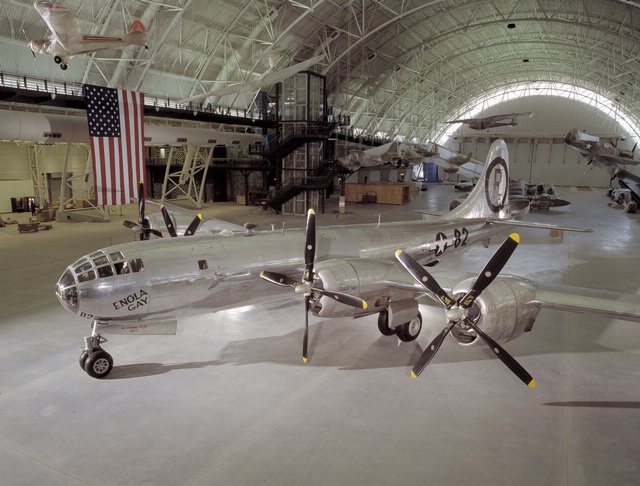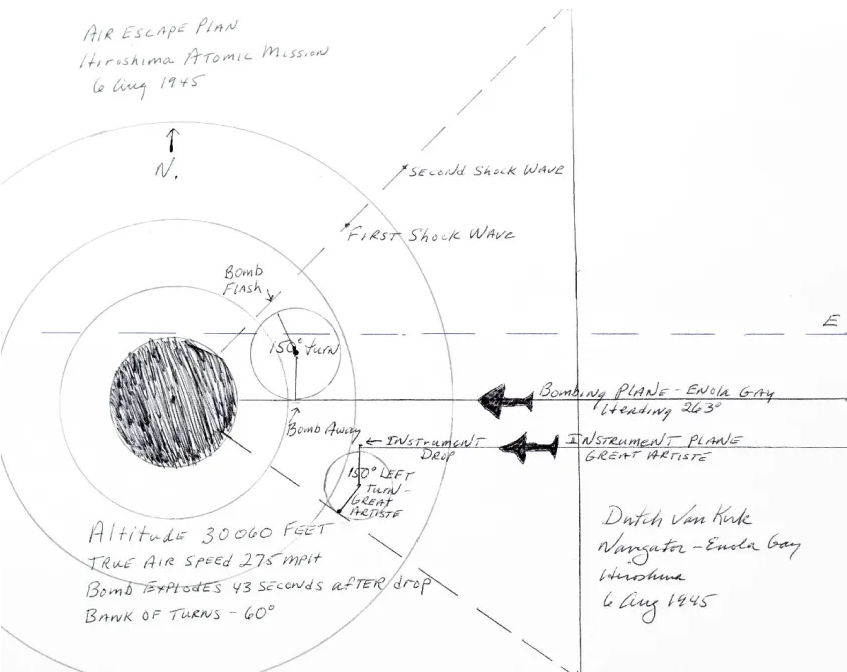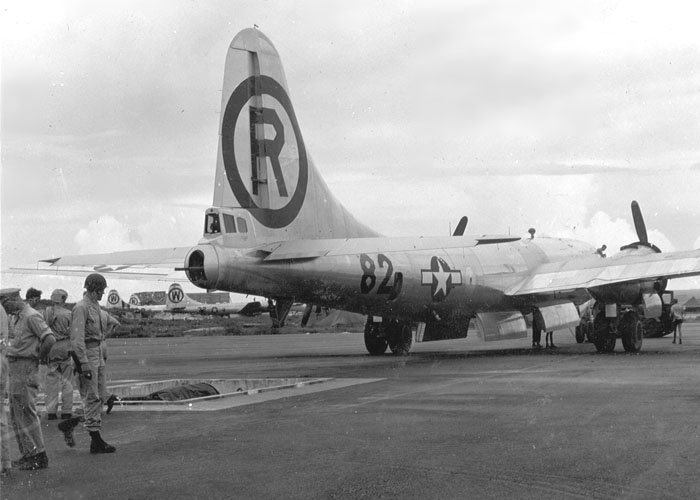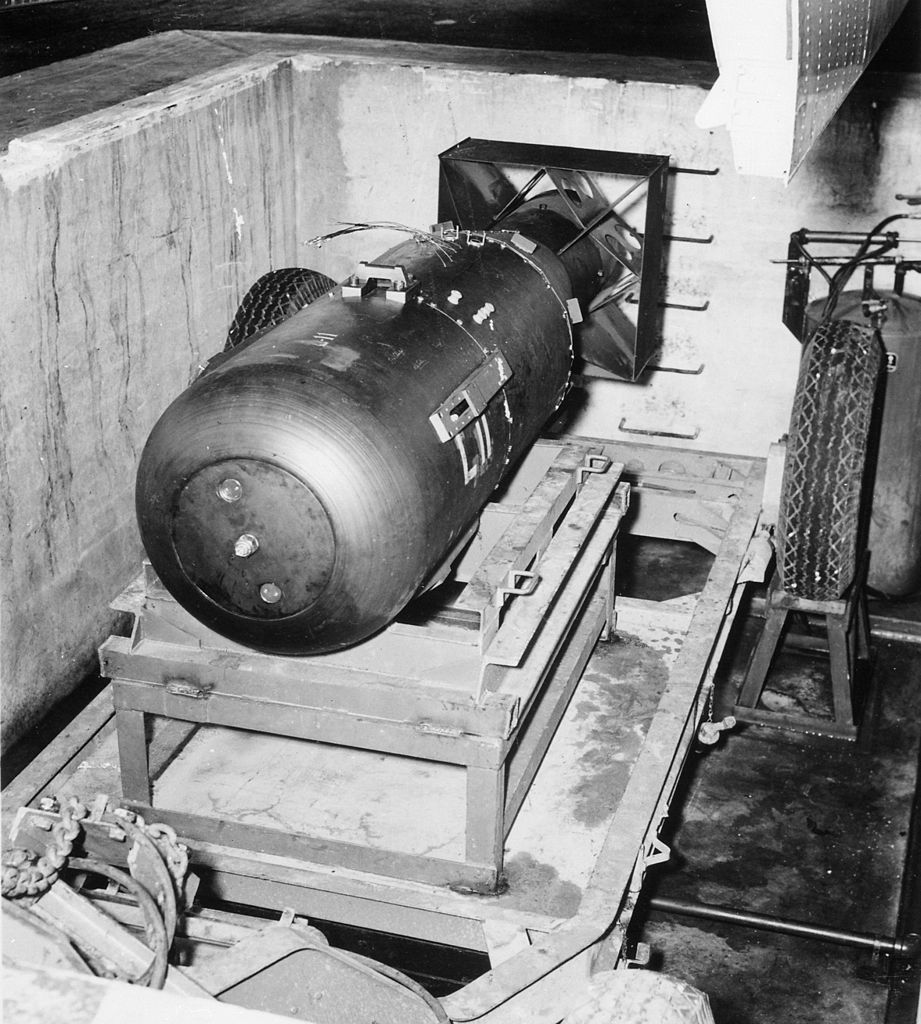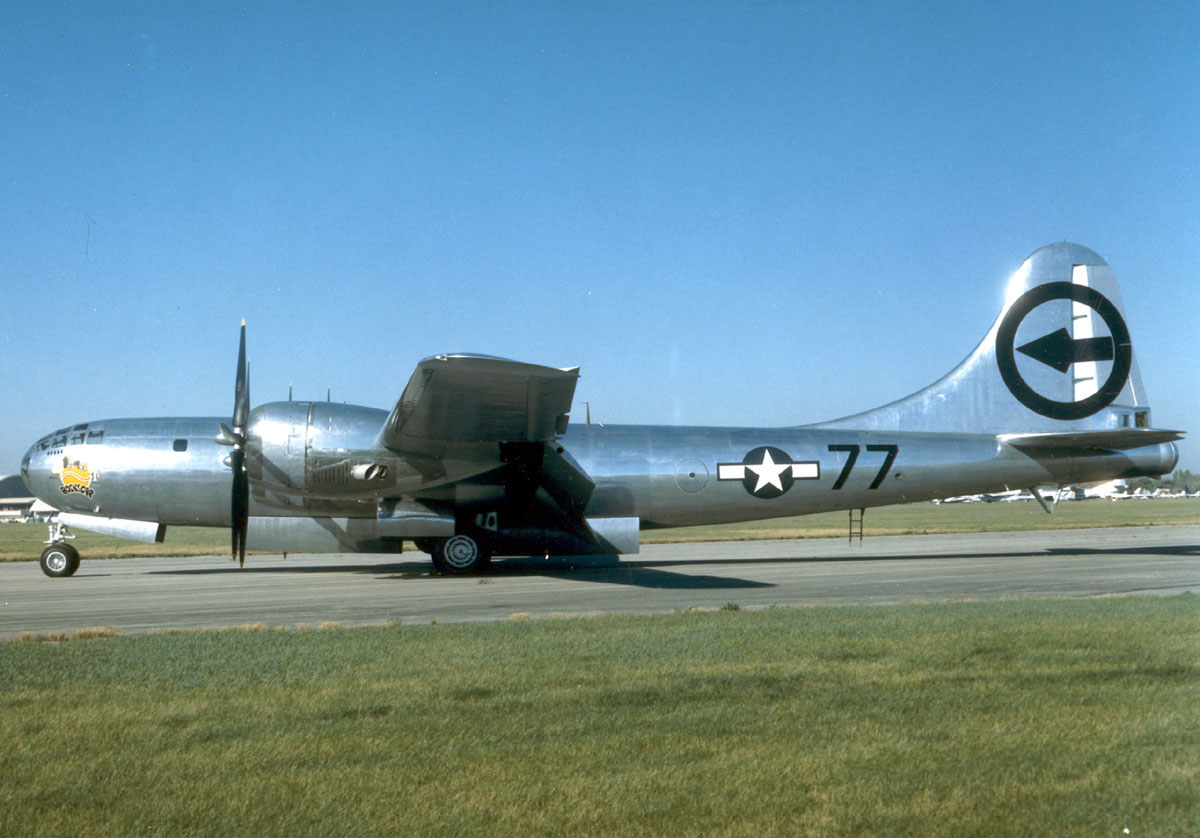
9 August 1945: Three days after an atomic bomb had been used against the Japanese industrial city of Hiroshima, a second attack was made on Nagasaki. Major Charles W. Sweeney,¹ in command of the Martin-Omaha B-29-35-MO Superfortress 44-27297, named Bockscar, departed Tinian Island in the Marshal Group at 3:47 a.m., and flew to Iwo Jima where it was to rendezvous with two other B-29s, The Great Artiste and The Big Stink, the instrumentation and photographic aircraft for this mission.
Like its sistership, Enola Gay, 44-27297 was a specially modified “Silverplate” B-29. The Silverplate B-29s differed from the standard production bombers in many ways. They were approximately 7,200 pounds (3,266 kilograms) lighter. The bomber carried no armor. Additional fuel tanks were installed in the rear bomb bay. The bomb bay doors were operated by quick-acting pneumatic systems. The bomb release mechanism in the forward bomb bay was replaced by a single-point release as was used in special British Lancaster bombers. A weaponeer’s control station was added to the cockpit to monitor the special bomb systems.
Bockscar had four air-cooled, supercharged, 3,347.662-cubic-inch-displacement (54.858 liter) Wright Aeronautical Division R-3350-41 (Cyclone 18 787C18BA3) two-row 18-cylinder radial engines with direct fuel injection. The R-3350-41 had a compression ratio of 6.85:1 and required 100/130 aviation gasoline. It was rated at 2,000 horsepower at 2,400 r.p.m. at Sea Level, and 2,200 horsepower at 2,800 r.p.m, for take-off. The engines drove four-bladed Curtiss Electric reversible-pitch propellers with a diameter of 16 feet, 8 inches (5.080 meters), through a 0.35:1 gear reduction. The R-3350-41 was 6 feet, 2.26 inches (1.937 meters) long, 4 feet, 7.78 inches (1.417 meters) in diameter and weighed 2,725 pounds (1,236 kilograms).
With the exception of the tail gunner’s position, all defensive armament—four powered remotely operated gun turrets with ten .50-caliber machine guns—were deleted. Their remote sighting positions were also removed. Enola Gay carried 1,000 rounds of ammunition for each of the two remaining Browning AN-M2 .50-caliber machine guns in the tail.
With these changes, the Silverplate B-29s could fly higher and faster than a standard B-29, and the fuel-injected R-3350-41 engines were more reliable. Bockscar had a cruising speed of 220 miles per hour (354 kilometers per hour) and a maximum speed of 365 miles per hour (587 kilometers per hour). Its service ceiling was 31,850 feet (9,708 meters) and its combat radius was 2,900 miles (4,667 kilometers).
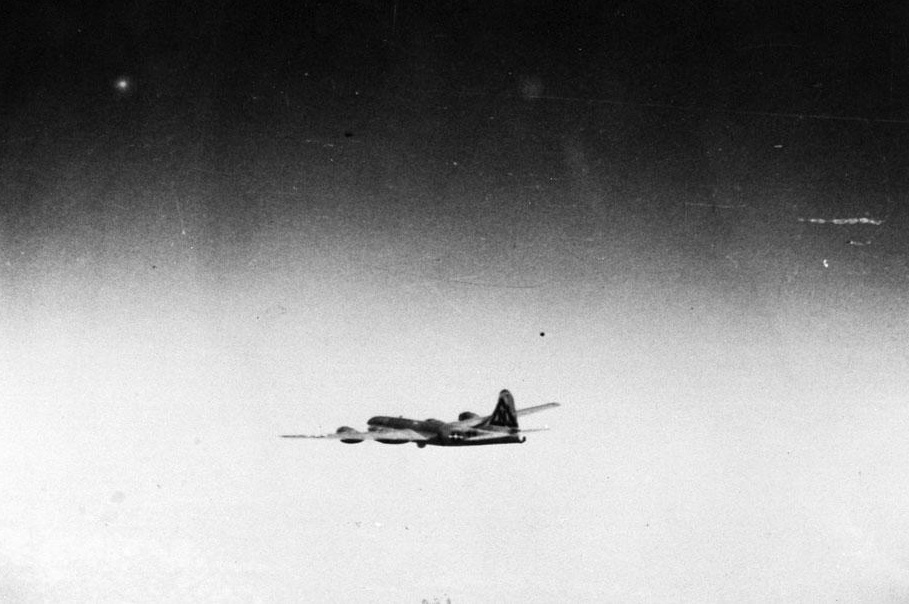
44-27297, Victor 7, was assigned to aircraft commander Captain Frederick C. Bock and his crew. Major Sweeney and his crew ordinarily flew The Great Artiste. Sweeney’s B-29 had been the the instrumentation aircraft for the Hiroshima mission and there was not time to remove that equipment and re-install it aboard Bock’s bomber, so the crews switched airplanes. For operational security, Bockscar‘s normal identification was changed from the number 7 on the fuselage to 77. The 509th’s tail code of a circle surrounding a forward-pointing arrow was changed to another unit’s “Triangle N” identification.
All of these last minute changes resulted in confusion in contemporary reports as to which B-29 had actually dropped Fat Man on Nagasaki.
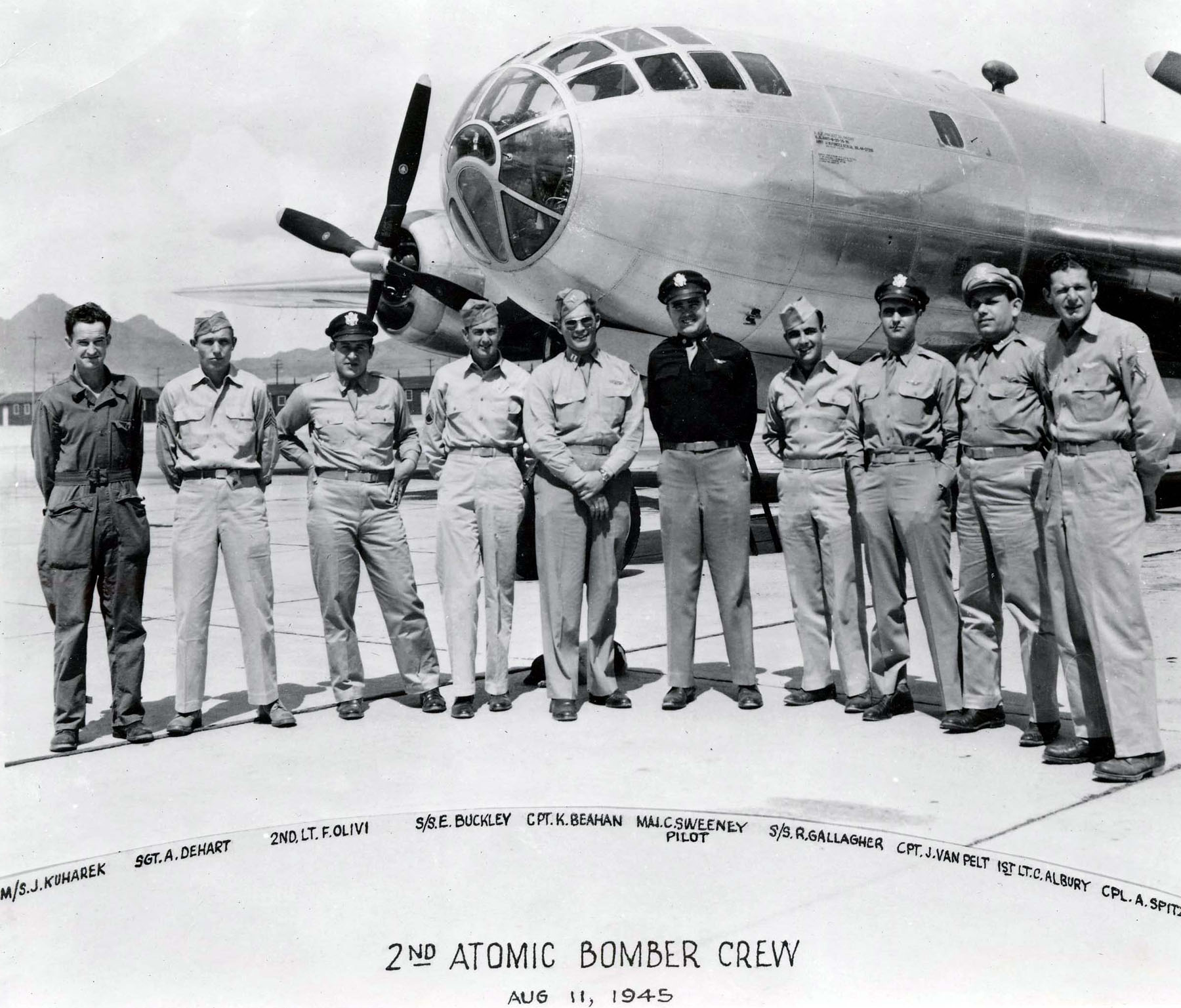
In Bockscar‘s forward bomb bay was a 10,213 pound (4,632 kilograms) bomb called Fat Man. This was a completely different and much more complex weapon than the Little Boy (Mark I) atomic bomb dropped by Colonel Paul Tibbet’s Enola Gay on 6 August. The bomb was 12 feet, 8⅜ inches ¹ (3.261 meters) long, 5 feet, ¼ inch ² (1.530 meters) in diameter,
Designated Mark III, the egg-shaped weapon contained a 9.17 centimeter (3.61 inches), 6.15 kilogram (13.6 pound) sphere of Plutonium Pu 239, with a 2.1 centimeter (0.83 inch) hollow cavity at its center. A beryllium neutron initiator was in this cavity. The plutonium sphere was surrounded by a 22.86 centimeter (9.0 inch) diameter uranium tamper with a mass of 108 kilograms (238 pounds). This nuclear assembly was contained in a boron/acrylic shell and surrounded by about 2,390 kilograms (5,269 pounds) of high-explosive, consisting of Composition B and Baratol. The explosives were formed in “lenses” that would direct the force inward in a very precise manner. The purpose was to compress—or implode— the Plutonium to a much greater density, resulting in a “critical mass.”
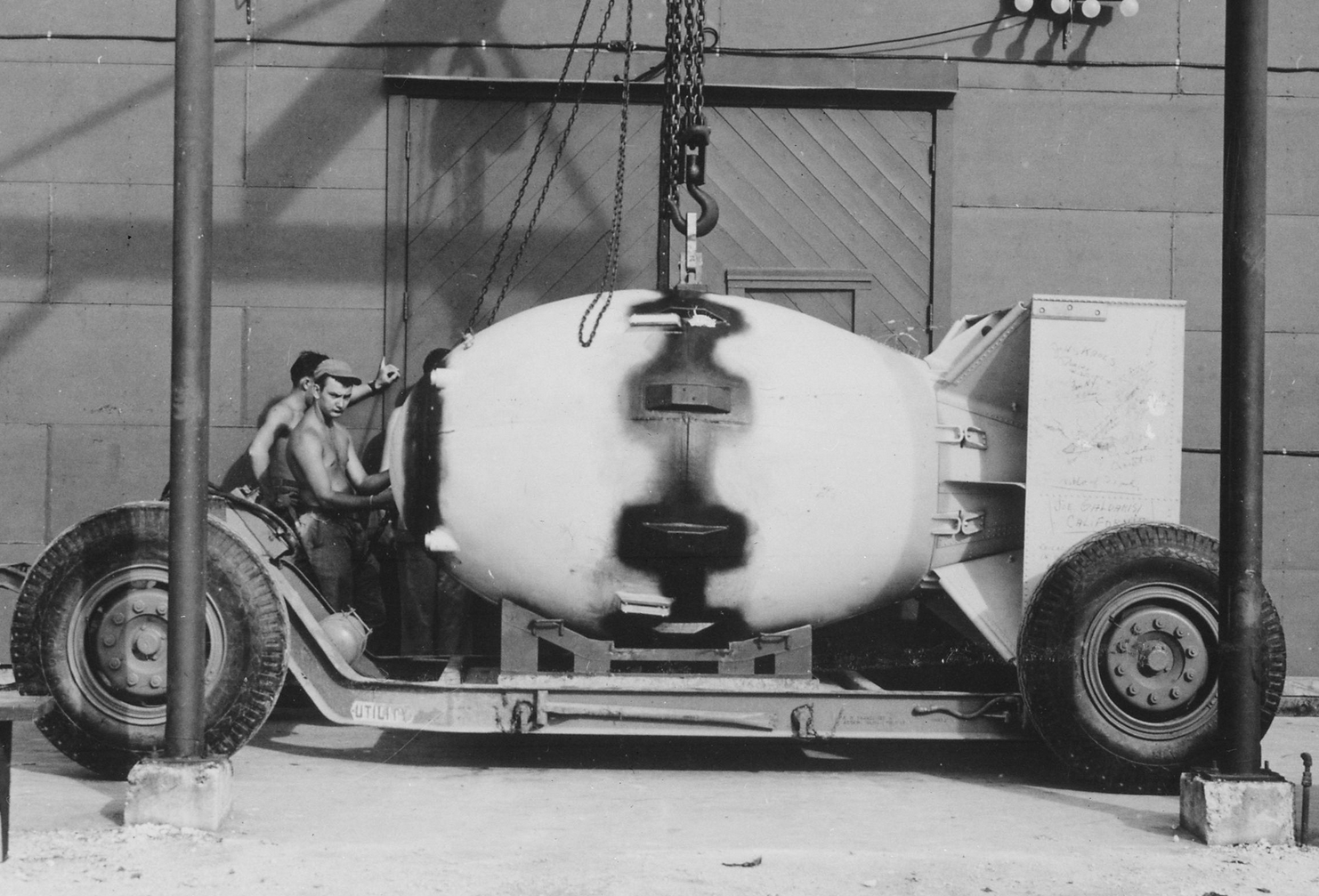
In the conduct of this mission, Major Sweeney made a number of serious errors that nearly caused the mission to fail, and might very well have led to the loss of the bomber and its crew.
Prior to takeoff, the B-29’s crew chief informed Sweeney that a fuel transfer pump was inoperative which made it impossible to transfer 625 gallons (2,366 liters) of fuel from one fuel tank. This meant that nearly 9% of the total fuel load of 7,250 gallons (27,444 liters) was unusable. Chuck Sweeney decided to go anyway.
Next, though under direct orders from the 509th Composite Group commander, Colonel Paul Tibbets, to wait at the rendezvous no more than 15 minutes, when The Big Stink failed to arrive on schedule, Sweeney elected to stay 30 minutes beyond that.
Meanwhile, the two weather reconnaissance B-29s, Enola Gay and Laggin’ Dragon, were over Kokura, the primary target, and the secondary, Nagasaki. Weather over both cities were within the mission parameters.
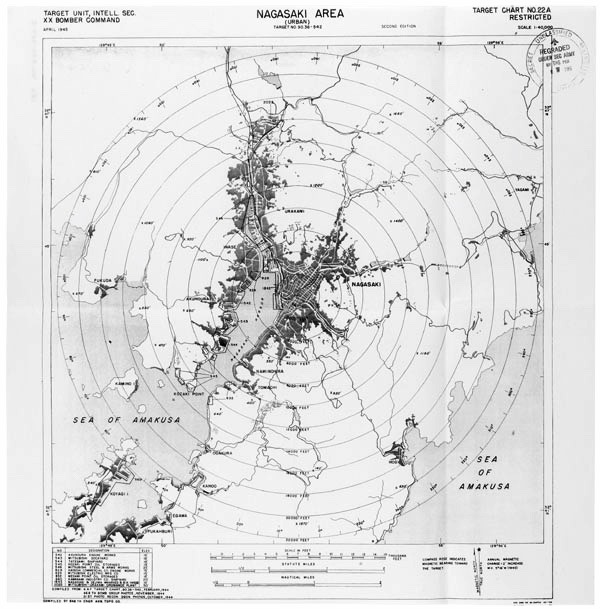
During the 45 minutes that Sweeney waited at the rendezvous, weather over Kokura had deteriorated. By the time Bockscar arrived overhead, clouds covered the city. The bomber made three attempts to bomb the city over a 50-minute period, but the bombardier was not able to see the target.
Now an hour and twenty minutes behind schedule, Sweeney diverted to the secondary target, Nagasaki. Because of the delays and the unusable fuel as a result of the failed fuel pump, Sweeney reduced engine power to try to conserve fuel during the twenty minute flight to the alternate target. But weather there had also deteriorated.
Sweeney decided that they should bomb through the clouds using radar, but at the last minute, the bombardier was able to see the aim point. The Fat Man was dropped from 30,000 feet (9,144 meters) at 11:01 a.m. After falling for 43 seconds, the atomic bomb detonated at an altitude of 1,950 feet (594 meters). It missed the intended target point by nearly 1.5 miles (2.4 kilometers) and exploded over the Urakami Valley, halfway between the Mitsubishi Steel and Arms Works and the Mitsubishi-Urakami Ordnance Works.
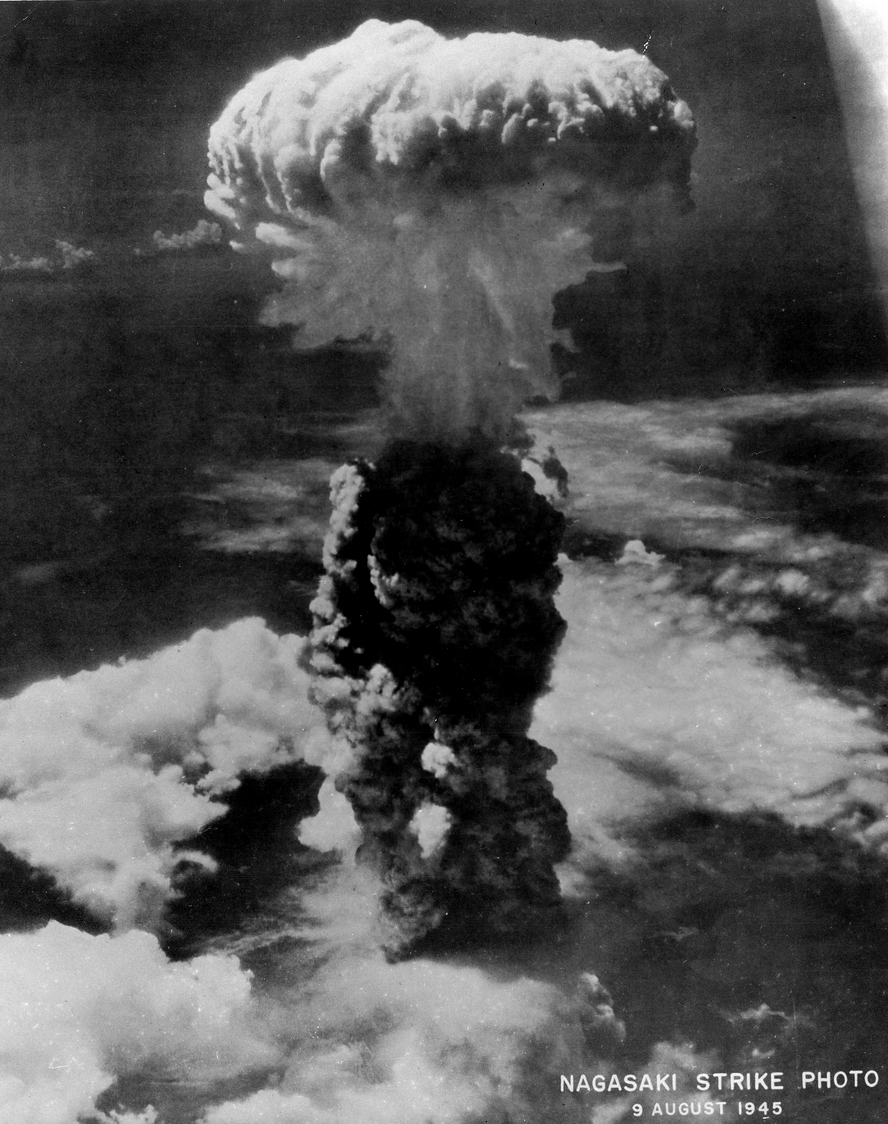
The estimated force of the explosion was 21 kilotons—equivalent to the explosive force of 21,000 tons of TNT (19,050 metric tons)—nearly 20% greater than the Hiroshima bomb. The surrounding hills contained the explosion, protecting a large part of the city. Still, approximately 60% of Nagasaki was destroyed and 70,000 people were killed. By December 1945, at least 80,000 of the city’s 250,000 residents had died.

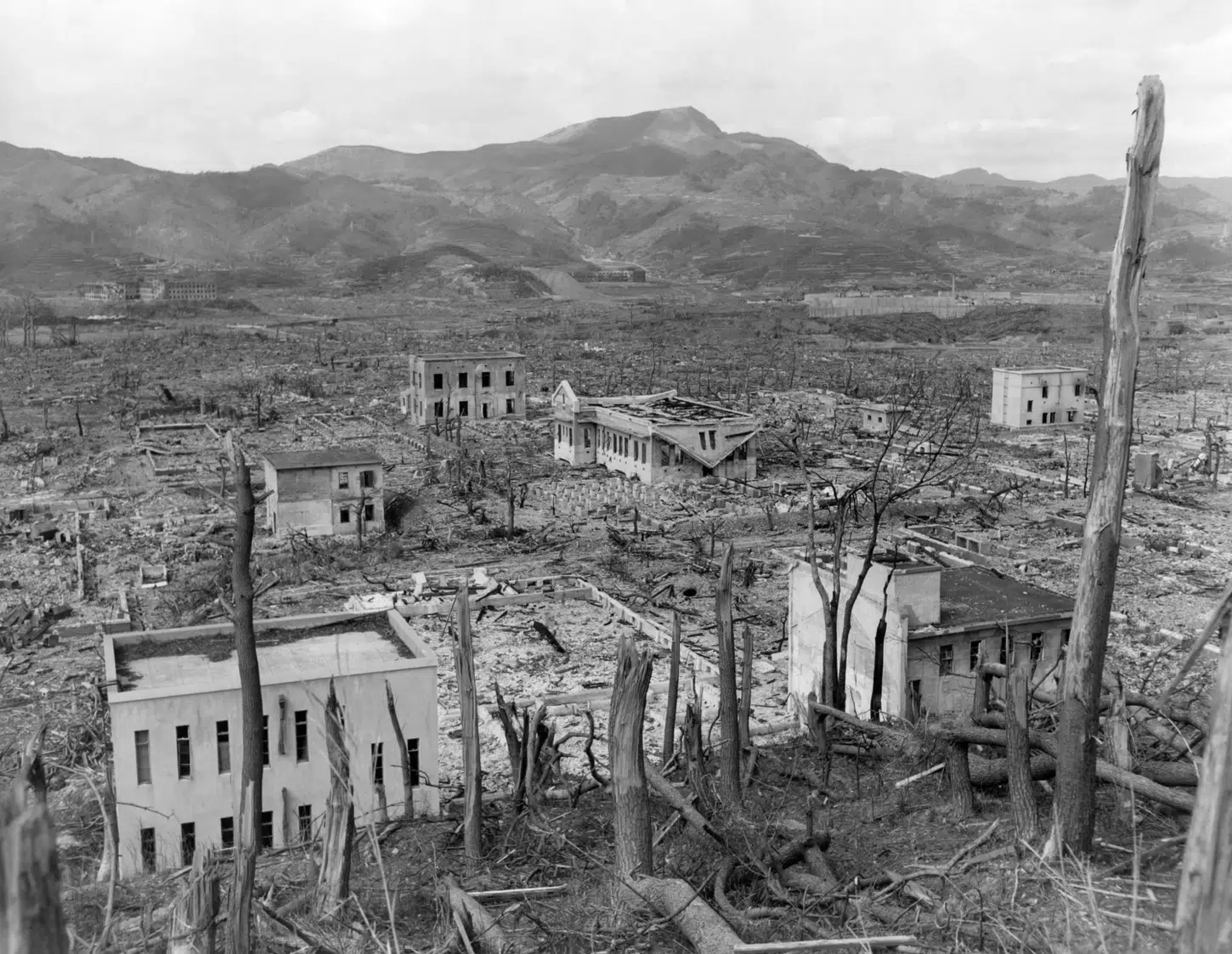
Now critically low on fuel and unable to reach the emergency B-29 recovery field on Iwo Jima, Sweeney headed for the airfields of Okinawa. When Bockscar touched down on the runway, one engine quit due to fuel starvation. As they turned off the runway, a second engine ran out of fuel. Charles Sweeney had cut it very, very close.
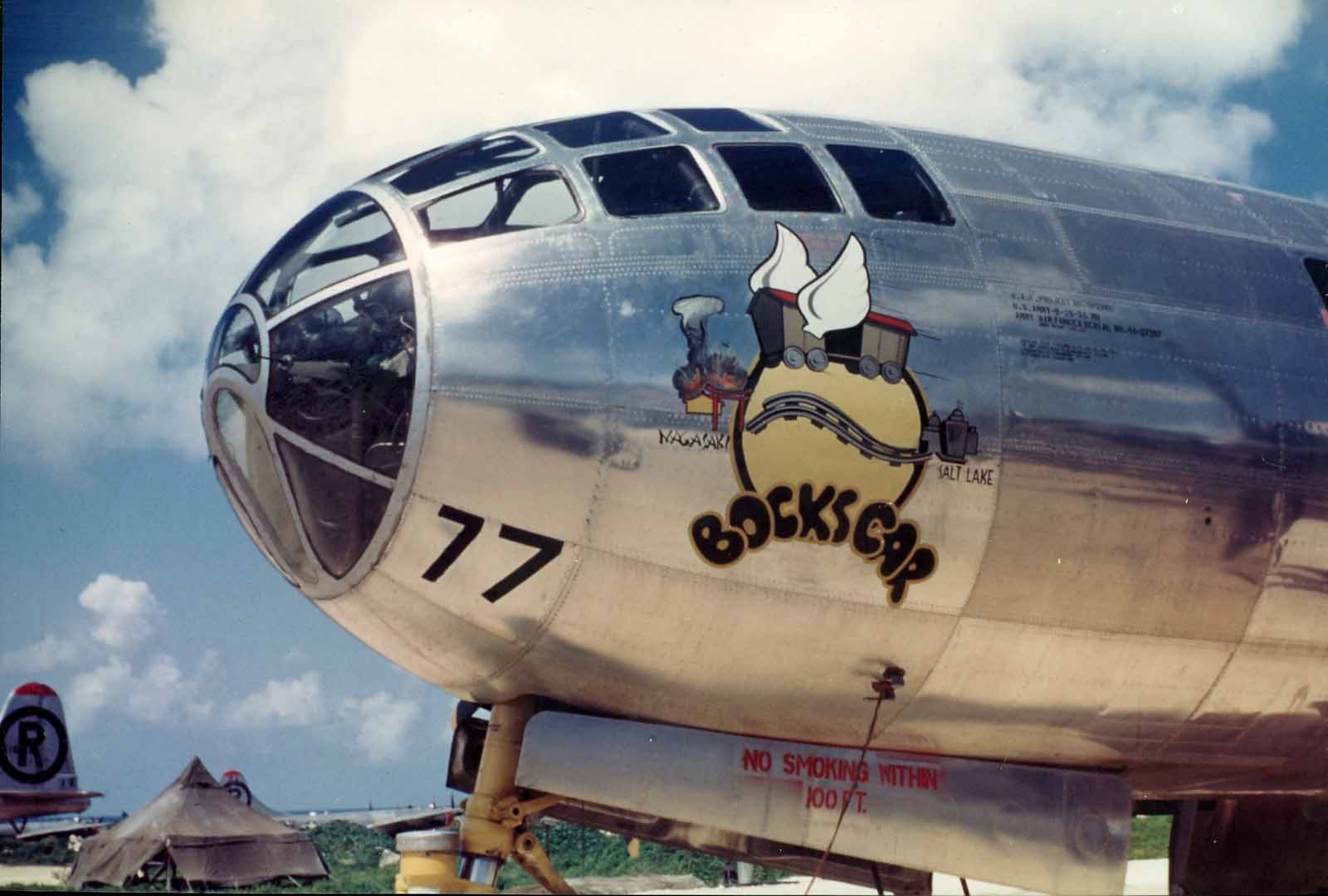
Five days after the bombing of Nagasaki, the Emperor of Japan—recognizing that his country now faced total destruction—agreed to surrender. World War II was over.
In 1946, Bockscar was placed in storage at Davis-Monthan Army Air Field, Tucson, Arizona. On 26 September 1961, the B-29 was flown to the National Museum of the United States Air Force, Wright-Patterson Air Force Base, Dayton, Ohio, where it remains in the museum’s collection of historic aircraft.
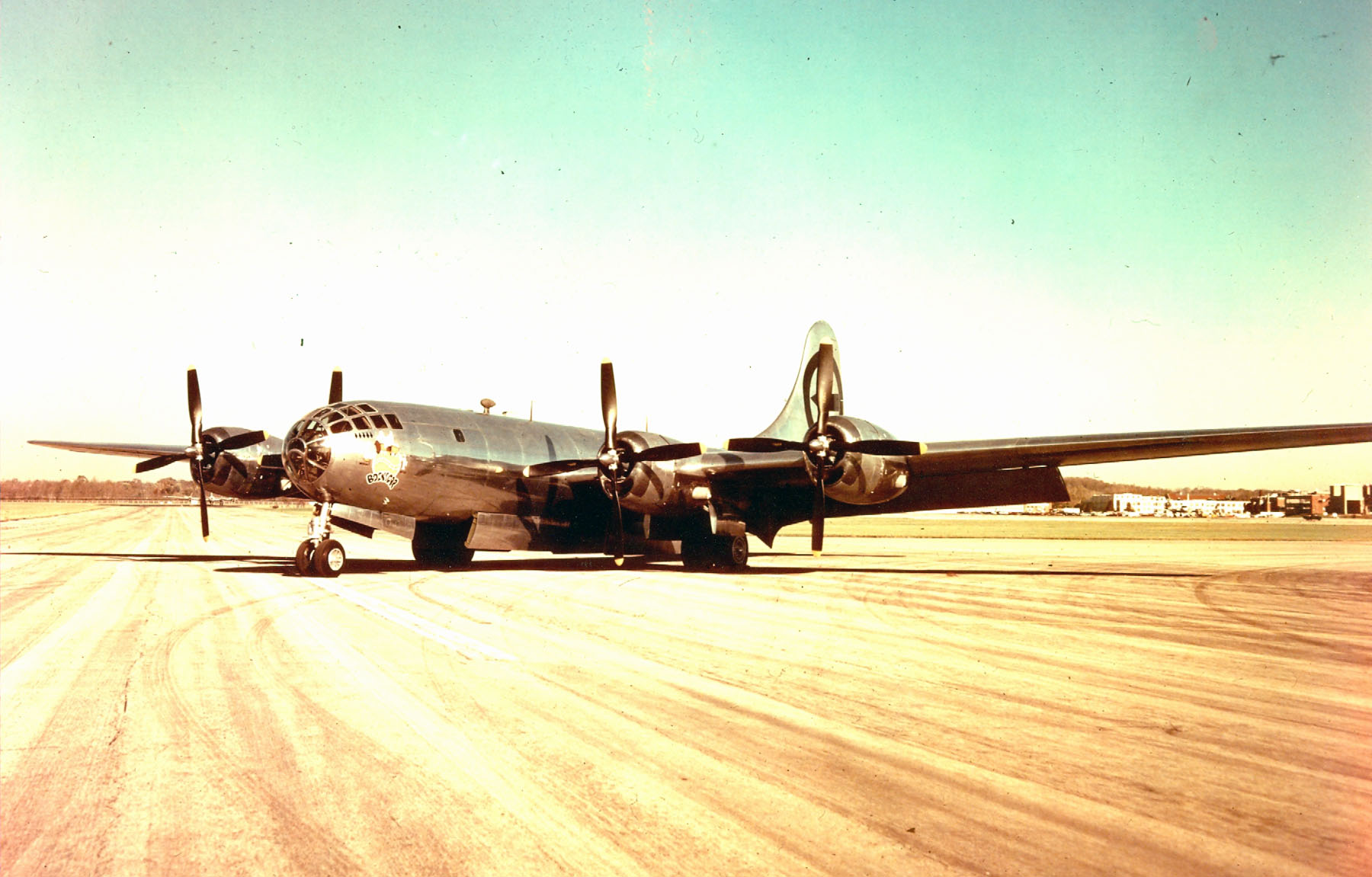
¹ The other members of the crew of Bockscar were Captain Charles Donald Albury, co-pilot; Second Lieutenant Frederick John Olivi, co-pilot; Captain James Frederick Van Pelt, Jr., navigator; Captain Kermit King Beahan, bombardier; Master Sergeant John Donald Kuharek, flight engineer; Staff Sergeant Raymond C. Gallagher, assistant flight engineer; Staff Sergeant Edward Kenneth Buckley, radar operator; Sergeant Abe M. Spitzer, radio operator; Sergeant Albert Travis Dehart, tail gunner; Commander Frederick Lincoln (“Dick”) Ashworth, U.S. Navy, weaponeer; Lieutenant Philip M. Barnes, U.S. Navy, assistant weaponeer; First Lieutenant Jacob Beser, radar countermeasures. (Lieutenant Beser also flew aboard Enola Gay, 6 August 1945.)
© 2023, Bryan R. Swopes
